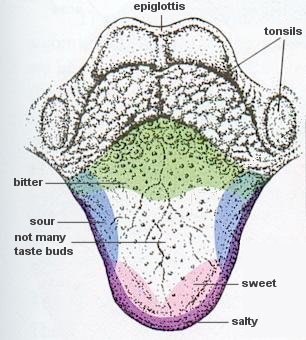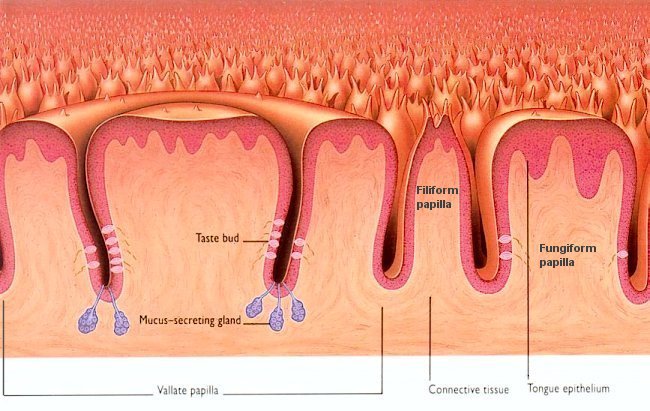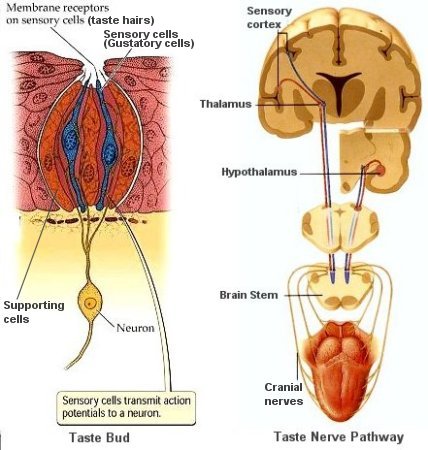continued from the Brain Page of
Nervous System
Contents
Neurons and Nerves
neurotransmitter
The Brain & Spinal Cord
Cranial Nerves
Peripheral Nervous System
Autonomic Nervous System
Senses:
Eye diagrams,
Hearing,
Smell,
Taste,
Taste & Tongue Sensation,
Balance
Memory ,
Memory
types, Creation of Memory,
Higher Functions
Altered States
[Top]
Taste (see location of the various
components in
Figure 09):
- Tongue - Embedded within the surface of the tongue are four
types of taste receptors localized in specific regions on the

 tongue (see Figure 19). Each detects a
different class of chemical: sweet (sugars), sour
(acids), bitter (complex organics), and salty (salts).
The "hot" sensation of foods such as chili peppers is
detected by pain receptors, not chemical receptors. But
a report in 2006 reveals that contrary to popular
belief, there is no tongue map. Responsiveness to the
five basic modalities - bitter, sour, sweet salty and
umami (a Japanese word
tongue (see Figure 19). Each detects a
different class of chemical: sweet (sugars), sour
(acids), bitter (complex organics), and salty (salts).
The "hot" sensation of foods such as chili peppers is
detected by pain receptors, not chemical receptors. But
a report in 2006 reveals that contrary to popular
belief, there is no tongue map. Responsiveness to the
five basic modalities - bitter, sour, sweet salty and
umami (a Japanese word
meaning the savory or meaty taste of amino acids) is present in all areas of the tongue.
Papillae - The papillae are those small elevations visible to
the naked eyes. There are three types of papillae located from the
back of the tongue toward the tip. Filiform papillae are generally
conical or pointed; fungiform papillae are flat-toped; vallate
papillae are larger with an outer groove (see Figure 20). Many taste
buds lie along the walls of the papillae. Isolated ones also are
present on the palate, the pharynx, and the epiglottis.
 Taste buds - The tasting, or gustatory, cells in the
buds have hairy tips which detect chemicals in solution
(secreted by the gland at the bottom of papilla). When
stimulated by flavor molecules, these cells generate nerve
signals, which they send to the taste center on the brain's
cortex, and also to the hypothalamus, which is concerned
with appetite and the salivating reflex.
Taste nerve pathway - The nerve signals are carried by
three nerves in each side of the tongue (cranial nerves) to
a small part of the medulla (brain stem). The signals then
travel to parts of the brain, such as the hypothalamus, the
thalamus, and the gustatory part of the sensory cortex - the
"taste center", where the signals are interpreted (Figure
21). The thalamus acts like a relay station, shunting the
data onto appropriate cortical areas for processing. The
sense of taste tells us what is good to eat. It evolved to
pick out sweet, ripe fruits and energy-packed sugars
[view large image]
Taste buds - The tasting, or gustatory, cells in the
buds have hairy tips which detect chemicals in solution
(secreted by the gland at the bottom of papilla). When
stimulated by flavor molecules, these cells generate nerve
signals, which they send to the taste center on the brain's
cortex, and also to the hypothalamus, which is concerned
with appetite and the salivating reflex.
Taste nerve pathway - The nerve signals are carried by
three nerves in each side of the tongue (cranial nerves) to
a small part of the medulla (brain stem). The signals then
travel to parts of the brain, such as the hypothalamus, the
thalamus, and the gustatory part of the sensory cortex - the
"taste center", where the signals are interpreted (Figure
21). The thalamus acts like a relay station, shunting the
data onto appropriate cortical areas for processing. The
sense of taste tells us what is good to eat. It evolved to
pick out sweet, ripe fruits and energy-packed sugars
[view large image]
and starches. Likewise, taste is is
extremely sensitive to bitter flavors, because many
poisonous berries, fruits and fungi are bitter-tasting.
Sensations (see location of the
various components in
Figure 09):
Skin - Skin has a thin epidermis, which is mainly for protection, and
a thicker dermis below. In addition to small blood vessels and
sweat glands, it has tiny nerve endings in the various type of
touch receptors (see Figure 09).
Receptors -
- Bulb of Krause - These are multi-layered capsules with
many branched nerve endings. They are quick-change
mechanoreceptors, triggered by rapid alterations in shap
caused by pressure or vibrations, and may also help us to
feel extreme cold.
- Free nerve endings - They have a treelike branching
system of naked nerve fibers. They are the most common
sensory endings in the skin and detect just about anything -
light touch, heavy pressure, heat, cold, and importantly,
pain. Slight stimulation of these nerve endings may elicit
the sensation that is known as itching.
- Meissner's endings - They are found in the uppermost
part of the dermis, especially on the hands, feet, lips, and
inner surfaces of the eyelids. They are shaped like eggs and
are both quick- and slow-change mechanoreceptors, detecting
light touch and vibrations.
- Merkel's endings - They are like tiny disks stuck in the
underside of the epidermis, where they feel slight changes
in its shape, thereby detecting light touch. They are both
quick- and slow-change mechanoreceptors.
- Pacinian endings - They have layers like an onion and
are sited deep in the dermis. They pick up heavy pressure
and also fast vibrations, such as those from a tuning fork.
- Ruffini endings - They respond to sustained stress or
gradually altering shape. This means that they are
slow-change mechanoreceptors. They are found mainly in hairy
skin and are sausage- or spindle-shaped. It is thought that
they may also detect extreme heat.
Proprioceptors - The sense of position and movement of limbs
is dependent upon receptors termed proprioceptors (Figure 22a).
They are located in the joints and associated ligaments and
tendons that respond to stretching, pressure, and pain. Nerve
endings from these receptors are integrated with those received
from other types of receptors so that we know the position of
body parts.
Sensory nerves - Nerve impulses may reach the somatosensory
cortex for analysis before a response is decided. These result
in voluntary actions - a deliberate response. Sometimes the
stimulus require immediate action (such as from the burning
sensation), a reflex action is taken without the conscious
control of the brain. These are the involuntary actions directed
by the spinal cord. We only become aware of them when other
impulses are sent to the brain to "inform" what has happened.
The path which impulses travel along during a reflex action is
called a
reflex arc. Not all the body parts
Continue to Homunculus page

 tongue (see Figure 19). Each detects a
different class of chemical: sweet (sugars), sour
(acids), bitter (complex organics), and salty (salts).
The "hot" sensation of foods such as chili peppers is
detected by pain receptors, not chemical receptors. But
a report in 2006 reveals that contrary to popular
belief, there is no tongue map. Responsiveness to the
five basic modalities - bitter, sour, sweet salty and
umami (a Japanese word
tongue (see Figure 19). Each detects a
different class of chemical: sweet (sugars), sour
(acids), bitter (complex organics), and salty (salts).
The "hot" sensation of foods such as chili peppers is
detected by pain receptors, not chemical receptors. But
a report in 2006 reveals that contrary to popular
belief, there is no tongue map. Responsiveness to the
five basic modalities - bitter, sour, sweet salty and
umami (a Japanese word 